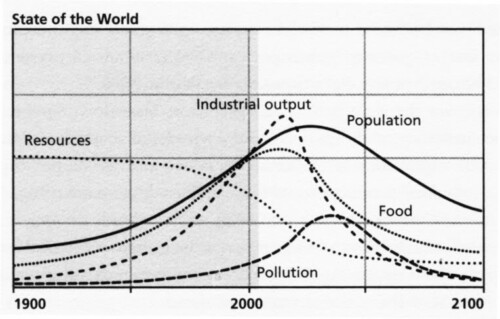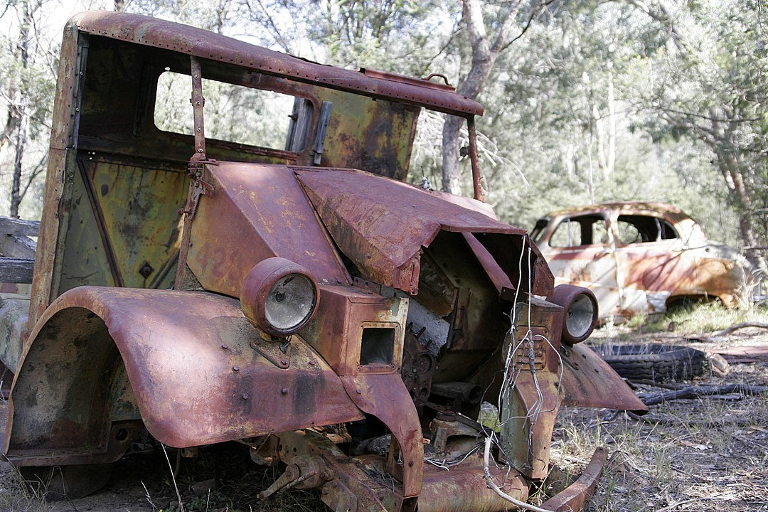I was ten years old when The Limits to Growth first saw print. I have a dim memory of seeing a newspaper article or two about it, but I had other things on my mind in 1972—my parents got divorced that year, and an already difficult childhood promptly got much worse—and several years passed before I found time to read it. Its portrayal of a future of hard limits made immediate sense to me. Somehow I never managed to absorb the widespread American conviction that there will always be more so long as you whine for it loudly enough, and so the book became one of the volumes that shaped my youthful sense of where the future was headed.
In the 1970s you could talk about such things. The public library in Burien, Washington where I got most of my reading fodder then was well stocked with books on energy and the environment. If I couldn’t find what I wanted there I could catch the Route 130 bus to the downtown branch of the Seattle Public Library, not yet replaced by the monument to architectural incompetence that now squats on its site, and bring home a double armload of volumes on similar topics. By that time, too, I had read enough to follow the logic of The Limits to Growth in detail.
It was not, as the corporate media insisted it was, a prophecy of doom. That’s one of the details that got swept under the rug by the mainstream back in the 1970s and still gets swept under the rug by the project’s critics today. The point of The Limits to Growth was that we as a species, and as a community of nations, had a choice. We could rein back on economic growth ourselves and embrace the promise of a steady state future in relative balance with the global biosphere, or we could ignore the limits to growth until we slammed into them, and topple over into a long ragged decline ending in a new dark age.
That was the choice. It’s crashingly unpopular these days to suggest that we could have chosen the former option, but that’s just sour grapes talking: we didn’t make that choice while we could, and so it’s emotionally easier for a lot of people to insist that it was never an option at all. I remain convinced that it could have happened. We had a window of opportunity; between the total failure of our managerial elite in the Vietnam war, the trauma of the 1973 oil embargo, and the revelations of government corruption and abuse of power that followed Watergate, enough people in the United States had been shocked awake, and we could have made the necessary changes while there was time for them to matter. The US Bicentennial in 1976 brought us close to that choice—closer, I think, than ever before or since—as a great many Americans thought about what we’d lost in our frantic quest for empire overseas and excess at home.
But we didn’t make that choice, and here we are.
I think most people have noticed that since the Covid shutdowns, product shortages have become a routine part of everyday life here in the United States. They aren’t drastic shortfalls, and which products are in short supply or absent from the shelves varies from place to place and even from store to store, but unless you shop at high-end stores that cater to the privileged classes, you run a fairly high chance of finding gaps on the shelves whenever you go shopping. To the extent that the media talks about this at all, it blames shipping and trucking problems on the one hand, and labor shortages on the other. Those are doubtless involved. With most industries dependent on just-in-time ordering, to begin with, the Covid shutdowns threw a monkey wrench into inventory systems that only work given stable conditions, and the shockwaves are still moving through a global economy too dependent on centralized production and worldwide transport.
The shutdowns also played an important role in the labor shortages, in an ironic way. One consequence that the politicians who ordered the shutdowns seemingly didn’t anticipate is that solitude and isolation give people the chance to think clearly about their lives. (That’s why monks and nuns live in what amount to permanent shutdown conditions.) Here in the United States, at least, one major consequence is that a very large number of people realized that their lives suck, their jobs suck, and the scant pay and benefits (if any) offered by their employers aren’t worth the miserable conditions, humiliating policies, and grotesque abuses of power that so many of them are expected to put up with in exchange for the privilege of having a job.
The result is being called the Great Resignation. One recent poll found that 55% of employed Americans are actively looking for other work. Quite a few people—I haven’t been able to find any hard numbers—are finding it under the table. The underground economy is a huge reality in today’s America, where a flurry of rent-seeking gimmicks on the part of governments, banks, real estate companies, and other financial parasites make it impossible for many perfectly legal businesses to make a profit if they follow the rules. One consequence is that businesses that have to operate aboveground are being squeezed hard by staff shortages.
I’m far from convinced, however, that the transportation bottlenecks and the labor shortages are responsible all by themselves for the increasingly common sporadic shortages that leave store shelves empty across the United States. One of the reasons I doubt this, in turn, is a famous chart from The Limits to Growth, which is shown below. Up to this point, as studies have shown repeatedly, it’s been more accurate as a model of the global economy than either the optimistic handwaving of its critics or the apocalyptic models brandished about by believers in sudden collapse. Take a good look at it, and notice that the first thing that happens to break the pattern of business as usual is a relatively steep decline in industrial output.

A familiar chart.
I’d like to suggest that the decline in output predicted in this chart is an essential part of what’s driving the cascade of spot shortages at present. Given the nature of today’s global economy, groaning as it is under the burdens of dysfunctional centralization and excess complexity, a flurry of seemingly unrelated shortfalls and delays is exactly how a contraction in industrial output would show up first, as marginal producers of components and raw materials fail to contribute their quotas to the manufacturing sector.
If this is correct, we have reached the point at which the decline in resource availability and the increase in the total pollution load on the environment and economy have begun to throw monkey wrenches into industrial output. If that’s the case, and the Limits to Growth model continues to be correct, the torrent of consumer goods that has defined so much of life in the world’s industrial nations is coming to an end in our time, and a cascade of other changes will follow in turn.
To make sense of those changes, let’s take a closer look at the chart and the logic underlying it. All the great scientific discoveries are based on immense simplifications. When Isaac Newton realized that the same force that causes an apple to fall from the tree keeps the Moon falling forever around the curve of the Earth, he erased a vast number of complicating factors to get to the principle that mattered. The creators of the World3 model that generated the chart above did the same thing in a smaller but still important way. To avoid the endless squabbling over which resources could substitute for other resources, they lumped all resources together as a single factor and tracked that factor’s availability over time.
They did the same thing with each of the other variables, lumping them together into broad categories: food, pollution, population, and industrial output. Then, using historical data as a basis, they worked out the relationships between these categories and put them through many different runs, each time tinkering with the variables or the relationships among them. Their critics went out of their way to avoid talking about this, because it didn’t matter what the authors of The Limits to Growth did, they got the same results—even with infinite resources, for example, population, food, and industrial production eventually tipped over into decline when the pollution curve went vertical. The standard run, which is the one shown here, embodied their best estimates, and the actual curves have followed it more closely than any other.
One of the advantages of lumping the variables together is that the myopia of single-factor theories is much easier to avoid. Back in the heyday of the peak oil movement, those of us who were paying attention to the big picture constantly had to remind others that petroleum wasn’t the only resource being used at unsustainable rates. These days, in fact, it’s hard to find a resource that isn’t being overused in this way. Did you know, to name just one example, that the world is running short of sand? The condominium in Florida that suddenly collapsed a little while back was an early casualty; corruption in the Florida building trades is legendary, and so plenty of contractors have been using cheap beach sand in place of proper building sand to make concrete. That yields weak, brittle concrete, with results we all saw in the headlines.
Thus we don’t have to run out of a resource entirely for shortfalls in that resource to affect industrial output. If a resource runs short and prices rise, that imposes one kind of burden. If it runs short and producers replace it with something substandard, that imposes another kind of burden. There are many other options, and all of them load costs on the economy. Those costs can be shoved off on someone else for a while—the economic history of the last half century is in large part made up of increasingly frantic attempts to shove off the costs on anyone within reach—but eventually they rise to the point that they cause enough interference to the production of goods and services that industrial output suffers.
The same rule applies to pollution. However you pollute the environment, somebody pays the bill. If you dump toxic waste in the river, people living downstream have higher medical costs, and that burdens the economy. If you put in water treatment plants to keep it from harming people downstream, this isn’t cheap, and that burdens the economy. If you modify your plant so that you no longer dump it in the river, you have to pay for it to go somewhere else, and that burdens the economy. If the cost of pollution mitigation gets too high, your plant goes out of business, and that burdens the economy. However you spin it, the economy gets hit, and eventually the total cost of dealing with pollution rises to the point that industrial output suffers.
As the chart above shows, industrial output isn’t the only thing to tip over into decline when this happens. Food peaks about the same time that industrial output does, for similar reasons, though it declines more slowly thereafter. Most of my readers will have noticed that the price of many foodstuffs is up sharply over the last year or so, and here again, sporadic shortages of some foods have become common. Some countries in the nondeveloping world have begun to face significant food shortages of a more general kind. Insisting that these are the result of the current round of droughts, and therefore don’t count, misses the point: “pollution” as a category includes, among many other things, the dumping of greenhouse gases into the atmosphere, and its impact on the economy includes the costs of drought and other results of climate change.
If this is what’s happening, what can we expect? First of all, many goods and services will become less available over the years immediately ahead. Some goods and services will rise dramatically in price as consumers compete for a diminished supply; some will be available at some times and places and not at others; some—especially those that don’t have any real value in the first place—will simply stop being made altogether. By 2100, if the World3 model continues to be accurate, industrial production will be about what it was in 1900. Population will still be around twice what it was in 1900, however, so serious poverty will be very common.
Meanwhile food prices will rise as food becomes less available. Some of that can be made up by cutting down on food waste—a fantastic amount of perfectly edible food is simply thrown away in the industrial nations nowadays—but not all. Population will peak and begin a slow decline not long after food and industrial output peak, and so outright starvation will tend to be limited to impoverished countries and classes except during periods of climate change-driven crop failure, but food costs will rise to make up a much larger share of family budgets in the years and decades ahead. Learning how to make cheap healthy foods stretch as far as possible will be an essential skill for most people as we proceed.
Global population is already cresting and the peak is nearly in sight. Even if no major disruption happens—a major war, a pandemic with a notably larger body count than the present example, or what have you—many people alive today will see Earth’s population begin to shrink. Some will see peak pollution, though that’s a little further in the future. By 2050, if the World3 standard run turns out to be correct, resource availability will have bottomed out at close to sustainable levels, all four of the other variables will have turned down hard, industrial output in particular will be at a modest fraction of current levels, and we will be living in a different world.
Now of course the first thing that comes to a great many minds when any such scenario gets discussed is flat denial, and I expect to see a lot of that. The second thing is the plaintive insistence that there must be some way to avoid having to go through the future thus sketched out. There was a way to do that, but the past tense—“was”—is essential here. If people had listened and taken action fifty years ago when the warning was first given, we’d have had plenty of time to make a smooth transition to a sustainable steady-state economy, back when our resource demands were much lower than they are now and the planet’s capacity to manage pollution wasn’t anything like so overburdened.
We didn’t do that, and now it’s too late. It really is as simple as that.
That doesn’t mean that all we can do is sit on our hands, moaning plaintively and waiting for death. There’s still an enormous amount that can be done to cushion the descent and make sure that as much as possible gets saved. (If you want to know the details, I’ve written half a dozen books about that, and I’m far from the only writer to have done so.) I know people who are doing many of those things, but they’re working on their own, or with the help of a few friends and allies. For the time being, most people are still stuck in the paired delusions that the universe will cater to their cravings no matter how extravagantly absurd those might get, and keep them from having to face the consequences of their actions no matter how callous and clueless those might have been. So far, at least, I haven’t yet seen anything that makes me think many of them will shake themselves out of that self-defeating trance.
That said, there are some eerie similarities to 1972 just now. The United States has just suffered a humiliating defeat after a long, clueless, and overwhelmingly corrupt Asian counterinsurgency campaign; the price of oil has been climbing raggedly upwards toward the edge of crisis territory; issues of political corruption and abuse of power are on a lot of Americans’ minds at the moment; and in a few years, in 2026, we’ll be celebrating the 250th anniversary of American independence. The same challenge we failed to confront fifty years ago faces us once again in even more unyielding terms. Maybe it’s possible, even this late in the game, that enough people will recognize the situation we’re in, and make the necessary efforts and sacrifices to do something constructive about it.
I admit that it seems unlikely to me. Still, when I look out the window at the bleak and battered landscape of a civilization in decline, what comes to mind more often than not these days is a song that was popular around the time The Limits to Growth originally saw print. To me, it has always summed up the spirit of the movement toward sustainability that rose and fell in those years. Some of my readers will doubtless find it naive and sentimental, but then that was said quite often of all the alternative movements of that era. Maybe we need to let go of the comforts of fashionable cynicism and find the courage to affirm such things again. Maybe a prayer for nonbelievers, to quote a line from the song, is what we need just now. We’ll just have to see.
Teaser photo credit: Old car rusting away. By This file is published under the following Creative Commons license:Attribution NonCommercial Unported 3.0 – Own work, GFDL 1.2, https://commons.wikimedia.org/w/index.php?curid=136219






